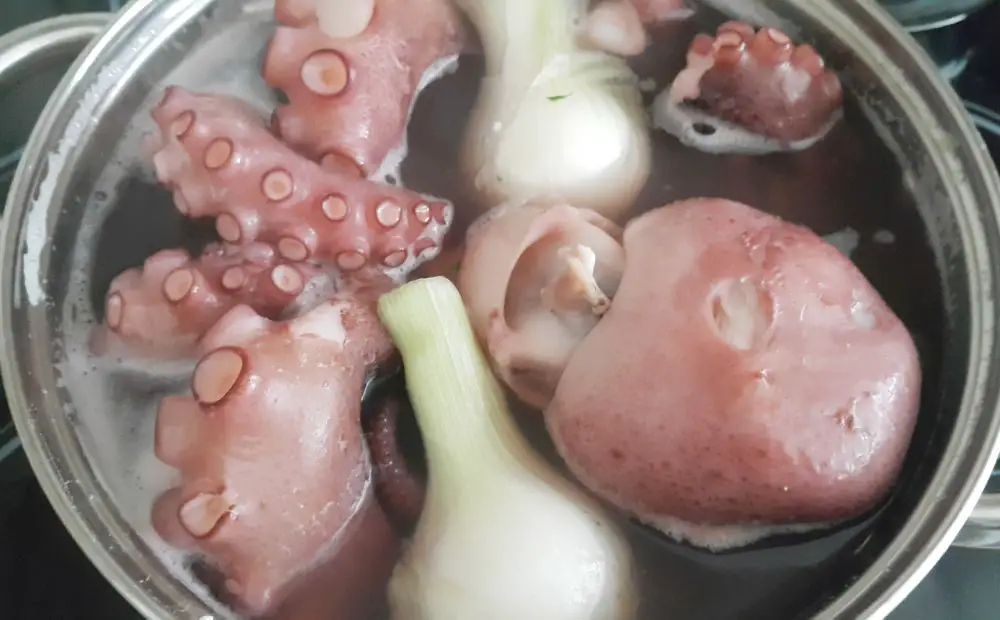Ljubljana related
Prekmurska gibanica originates from the Mura river region (Prekmurje literally means “across the Mura river (region)”) and is considered one of Slovenia's most recognisable culinary specialties.
The nutritious desert that is composed of two types of dough and four fillings was in the past reserved for special occasions only, as it wasn't cheap to make: a layer of shortbread at the bottom and four fillings in the prescribed order (poppy seeds; cottage cheese; walnuts; apples), each separated with a thin layer of filo (strudel) pastry.

In 2010 Prekmurska gibanica was awarded the Traditional Speciality Guaranteed Certificate, which is used to protect a recipe, ingredients or a method of preparation, while production is not geographically limited. This means one can produce (and sell) prekmurska gibanica anywhere in the world as long as the correct recipe is observed.
The recipe.
If we'll be making gibanica in a cake tin, we'll have to cut it into 16 cake pieces (the rules say so). Gibanica baked in rectangular pan will be cut into cubes. For a 40x35cm rectangular baking dish or a round pan of 30 to 35cm in diameter, we will need the following amount of ingredients.
Ingredients:
short pastry for the base
filo (strudel) pastry (9 sheets)
4 Fillings:
Poppy seed filling
30dag finely ground poppy seeds
10 dag granulated sugar
1 vanilla sugar (optional)
Cottage cheese filling
1.2kg full-fat cottage cheese
10 dag granulated sugar
2 eggs
pinch of salt
2 sachets of vanilla sugar (optional)
Walnut filling
30dag ground walnuts
10dag granulated sugar
1 vanilla sugar (optional9
Apple filling
1.5 kg apples (sour variety, grind)
12 dag of granulated sugar,
pinch of cinnamon
2 sachets of vanilla sugar
Toppings:
8 dl of fresh cream mixed with 3 eggs for the cream topping
25 dag of melted butter for the fatty topping
Once we’ve got all the fillings, pastry and toppings ready, we begin building gibanica by placing short bread pastry to the bottom of the baking tray. This part is called the foot or podplat in Slovenian. On the top of the short bread pastry we put one layer of filo pastry and half of the poppy seed filling on the top of that. The poppy seeds are then topped with some fatty and cream topping, before covered with another layer of filo pastry and the cottage cheese filling. The third filling is then walnuts, followed by apples. Each filling is covered with both toppings before a layer of filo pastry is placed on the top of those. The procedure with the fillings is then repeated in the same order once more and completes with a layer of filo pastry and cream and/or fatty topping.
Before gibanica is placed into a preheated oven for about an hour and a half, we prick it with a toothpick to prevent bubbles from forming.
Once baked, we leave it rest for at least four hours so that it won’t fall apart when sliced.
Dober tek!
August 13, 2019
Although the coconut slices (slo: kokosove kocke or čupavci) are believed – not by New Zealanders though - to be an invention of Australia’s Lord Lamington, they were accepted by Slovenian housewives some time ago and have since become an integral part of any celebratory table. It is therefore important for every woman living in the Slovenian countryside to learn how to bake some of these and avoid the disgrace when a baking emergency strikes. They are also easy to make and kids prefer them to potica.
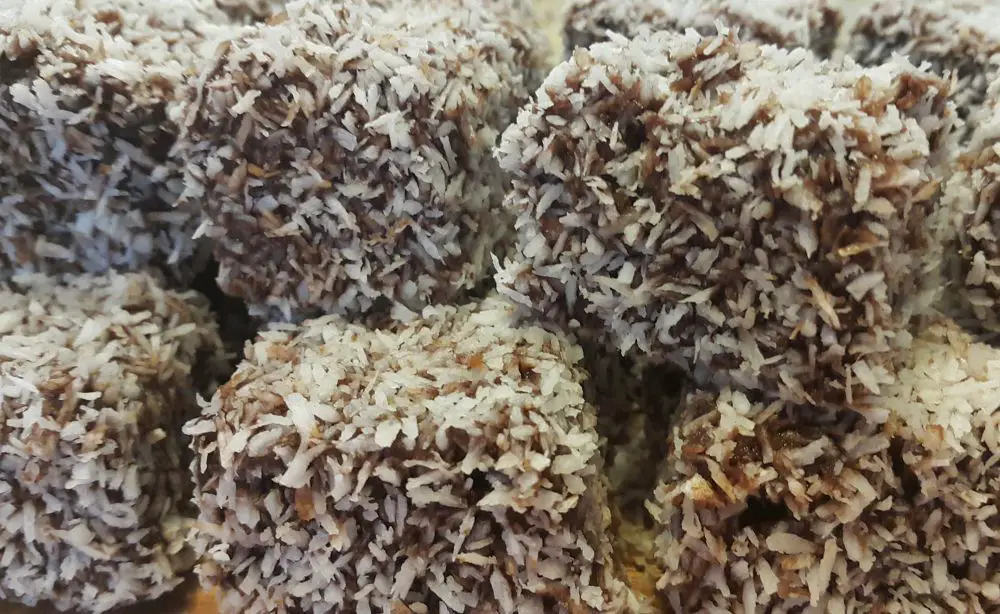
To explain as quickly as possible what these cakes are all about, we could just follow the Australian invention story, which goes that the Lord had unexpected guests once, so he took slices of old sponge cake, dipped them in chocolate, rolled them in ground coconut so that they wouldn’t stick to one’s fingers and served them to his guests. Basically that’s what coconut cubes are, only that they are made with fresh rather than stale sponge cake these days.

Mix the eggs, sugar, vanilla sugar, milk and butter into a smooth mixture, then mix in sifted flour with baking powder.
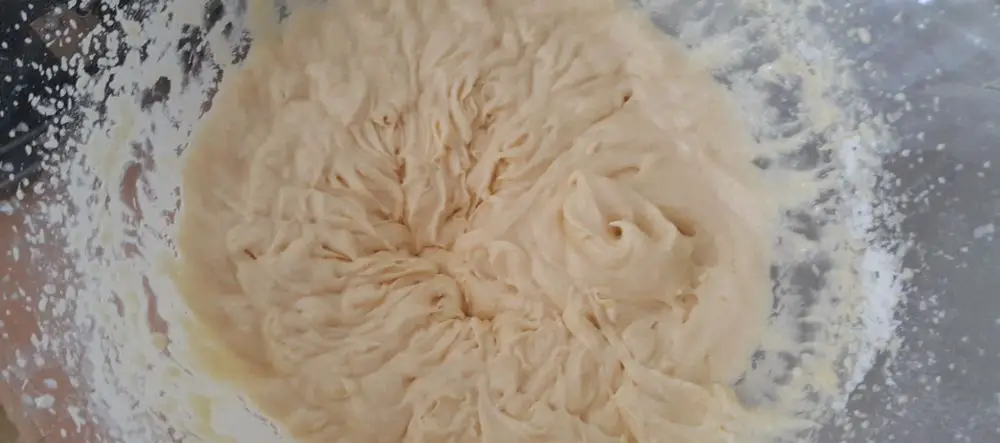
Prepare a baking tray with baking paper and pour the mixture in, then place into a preheated oven (175 degrees Celsius) for about 25 minutes.
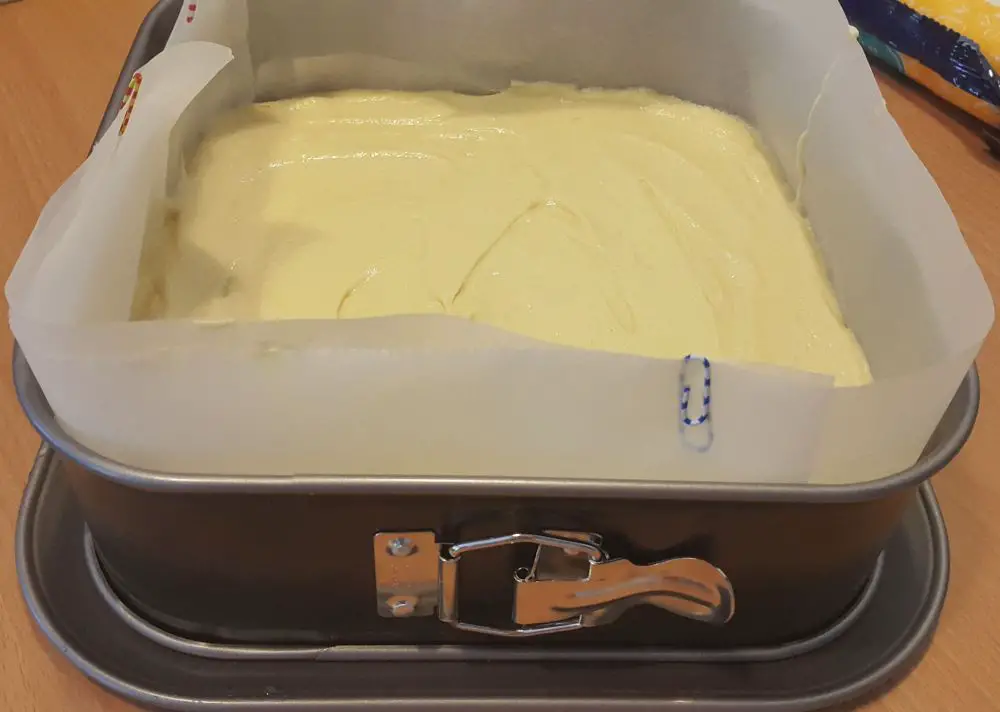
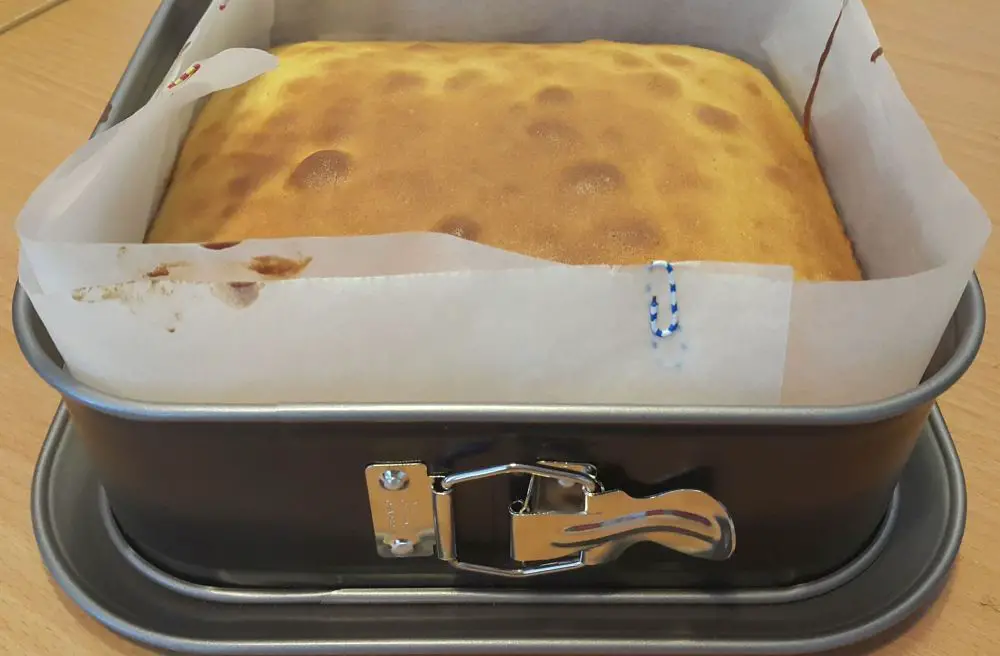
Meanwhile, melt the chocolate in milk and butter and cool down to body temperature. You might be sticking your fingers in it, so it shouldn’t be too hot. If it thickens too fast, add more milk.

Dice the cake. Note that final cubes will be much bigger than the pieces you cut when covered in chocolate and coconut. The goal is to get the right size of slices which will not break while soaking in the chocolate, but will also not be too big for someone to finish.
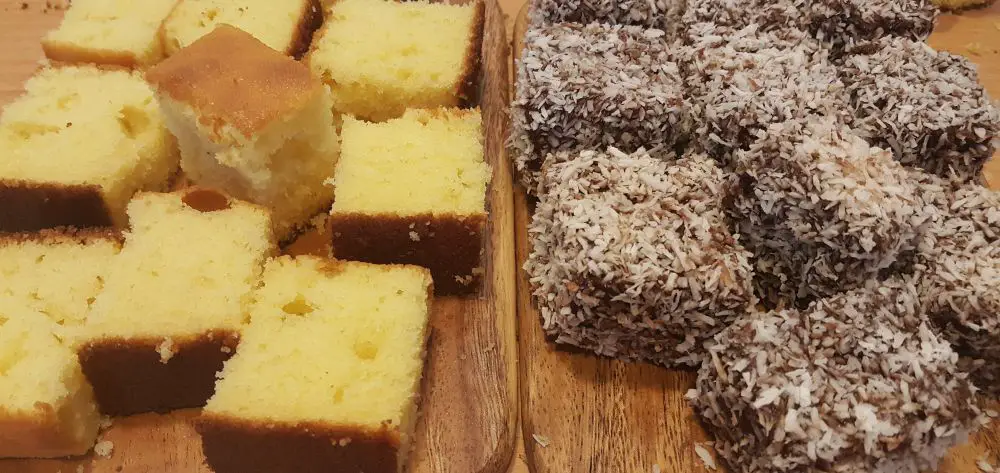
Soak the cubes in chocolate, then cover them in grated coconut. When the cubes are done, put them in the fridge for several hours so that they firm up.
Dober tek!
August 2, 2019
Bruschetta is an Italian word for grilled bread rubbed with fresh garlic and topped with whatever you want. In our case, the favoured topping is going to consist of sliced porcini fried in butter. As you can already suspect, this week’s recipe is more of an idea than a recipe itself.
What we’ll need is one or two fresh porcinis, some bread, butter, a clove of garlic and salt.
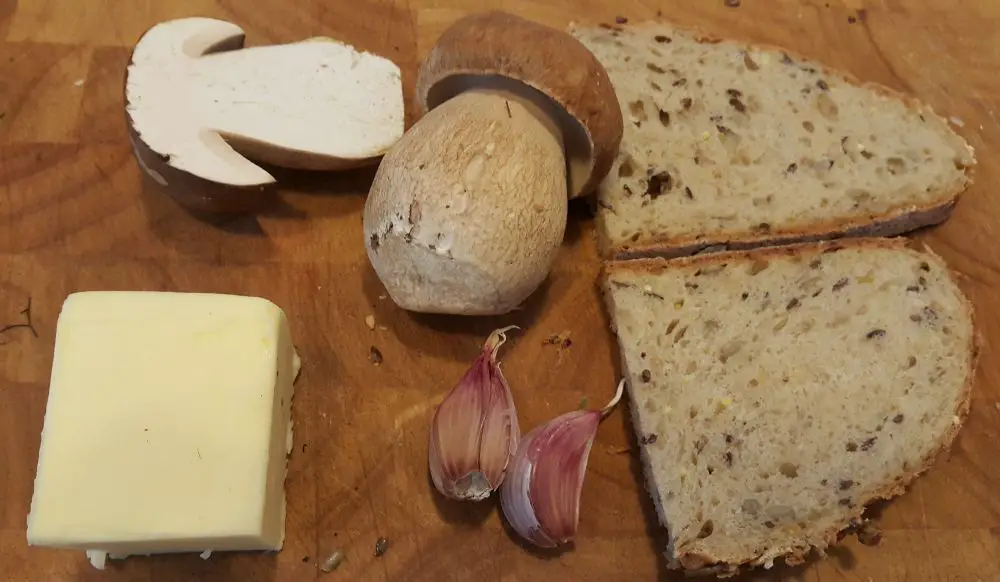
We put our bread into a preheated oven for 4 minutes or toaster if we have nothing else that day to bake and want to save energy. Bread should be hard enough for garlic to be rubbed on the top of it. We should peel the garlic clove first and cut it in half.
We then melt the butter in a pan, slice porcini and fry them on each side till they get some brownish colour. Add salt to taste while frying. When the porcini are done we place them on the top of our bruschetta. Serve while still warm.
Dober tek!
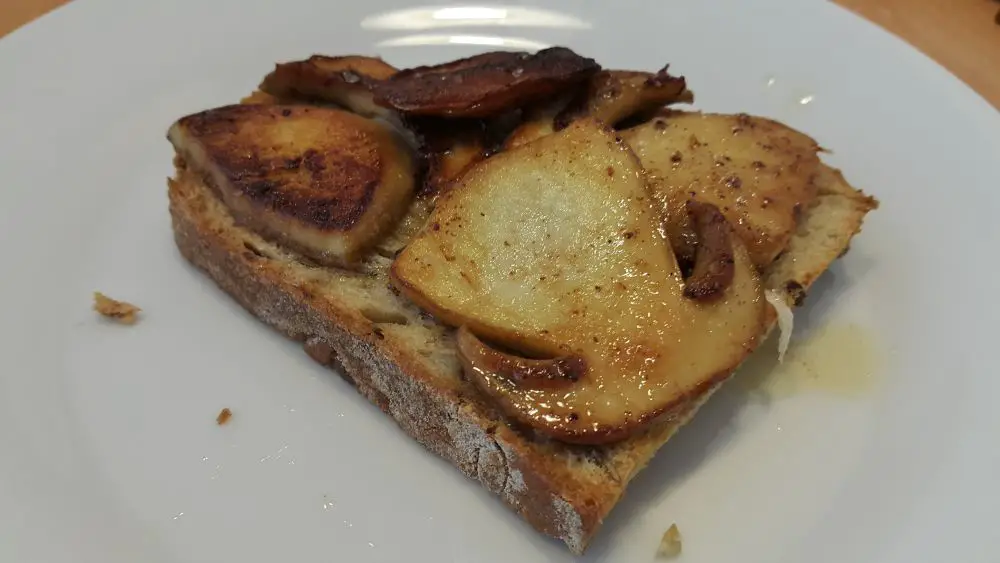
July 20, 2019
While some recipes require great technical skills, there are others that just require high-quality ingredients and minimal processing.
Fresh porcini (jurčki) are one of those ingredients that should be treated with some respect, and similar to truffles not to be destroyed with over-processing.
Mushrooms are not the easiest food to digest, which is why you should avoid eating them in the evening. Also, they are great with eggs, the main international breakfast ingredient.
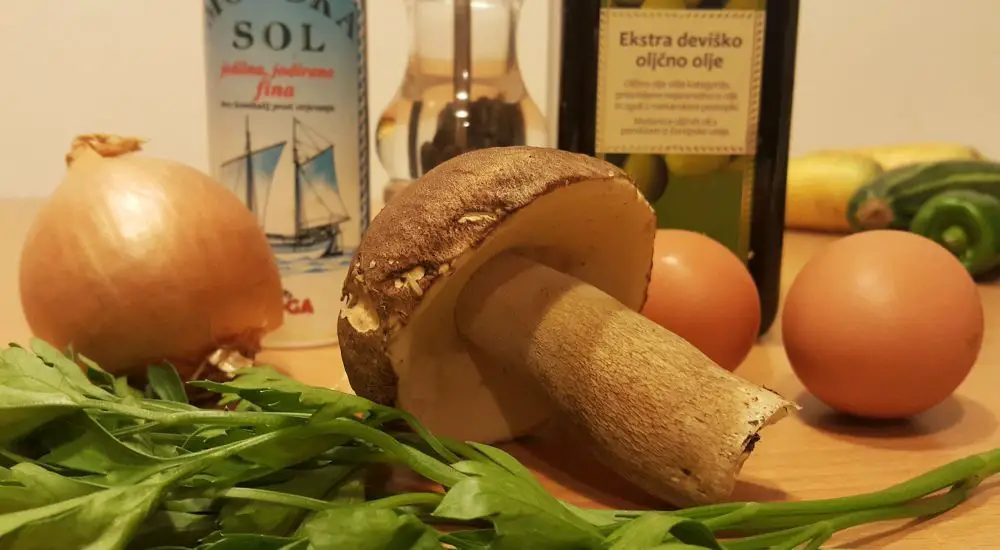
Ingredients (one person):
Scramble eggs in a bowl and add salt and pepper.
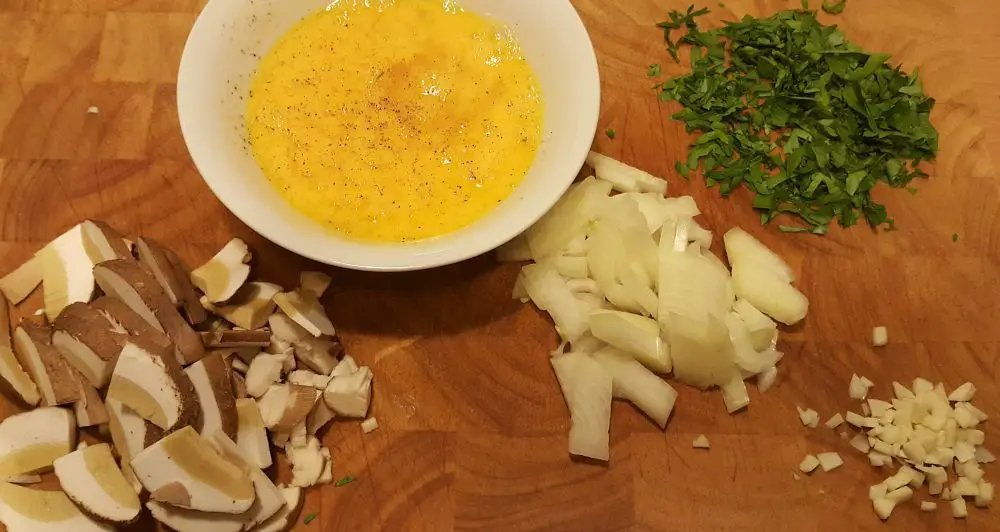
Stir fry chopped onion on olive oil till it loosens up, stir in garlic just so that it releases the fragrance, then add mushrooms. Stir fry and add a little water (or white wine) and simmer for about 10 min till all the liquid evaporates. The mushrooms should be slightly soggy, not white and a bit smaller once are cooked. Add the eggs into the pan and stir till they are done. Put on a plate, sprinkle parsley on top and serve immediately with a slice of bread.
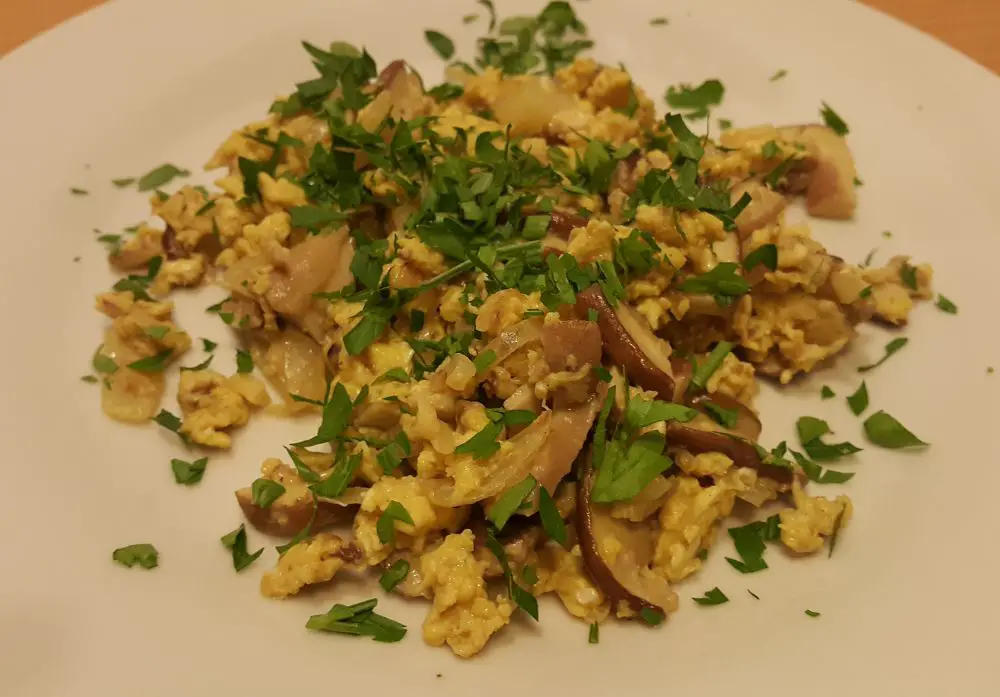
Dober tek!
July 16, 2019
With heat in the air and markets full of vegetables, an idea or two on healthy vegetable meals is always welcome, even for those who cannot get through the week without a steak.
What every sandwich must include is a spread, some umami taste and salad. In case you haven’t been following the taste science in the last few decades, apparently people can taste much more than just the four flavours we used to learn in school: sweet, sour salty and bitter. The fifth flavour is umami or savoury, the flavour of “cooked meat”, a sensation also triggered by glutamate- flavour enhancers found in Pringles and common in East Asian cuisine. It has been established that in combination with umami, much less salt is needed to achieve a certain desired effect of saltiness.
The vegetables with most of the umami flavour (natural, not added) are mushrooms, in particular, shiitake. We had no mushrooms, unfortunately, so we took a courgette. To make it up for all the missing umami, we used more salt and olive oil and placed all our bets on the spread instead.
A lover of Sichuan cuisine might have noticed not just the excessive use of hot peppers but the sweet savoury sensation of deep stir friend red peppers as well. We might conclude that the idea found its way to Europe in the form of goulash and satarash from Asia, if we didn’t know it actually came from the new world in the “Columbian Exchange” much later on.
Red peppers in a combination with walnuts became the basis for a famous Levantine dip known as Muhammara, which is what we chose for our spread.
So, let’s get to work.
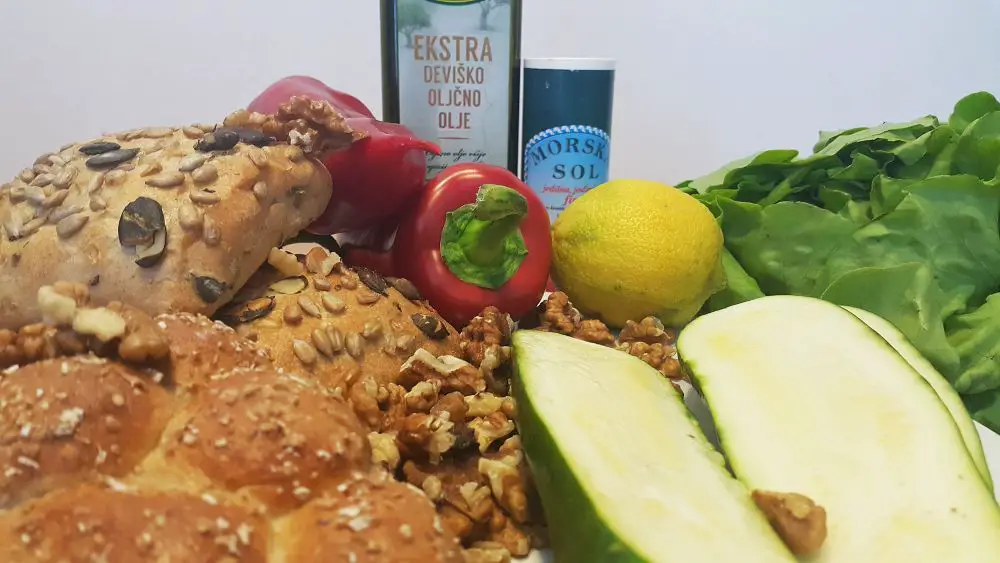
Ingredients:
Red pepper walnut spread:
The spread.
The red pepper variety that is normally used in the dip we are making is bell peppers, which are then peeled after roasting. I don’t know where or why this preference came about, as pimentos (red peppers with a pointy tip) are so much better for roasting and also have a much thinner skin, which doesn’t need to be peeled at all.
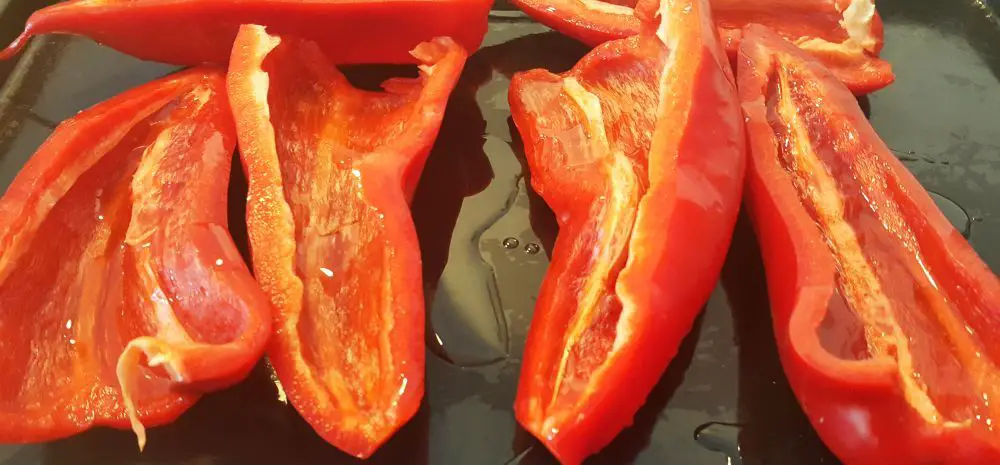

The process is simple: Blend the roasted peppers with all the ingredients listed above. If the mixture is too dry and doesn’t blend smoothly, add more olive oil, or add walnuts in several stages. Taste while making it to decide whether more salt, lemon juice or spice is needed.
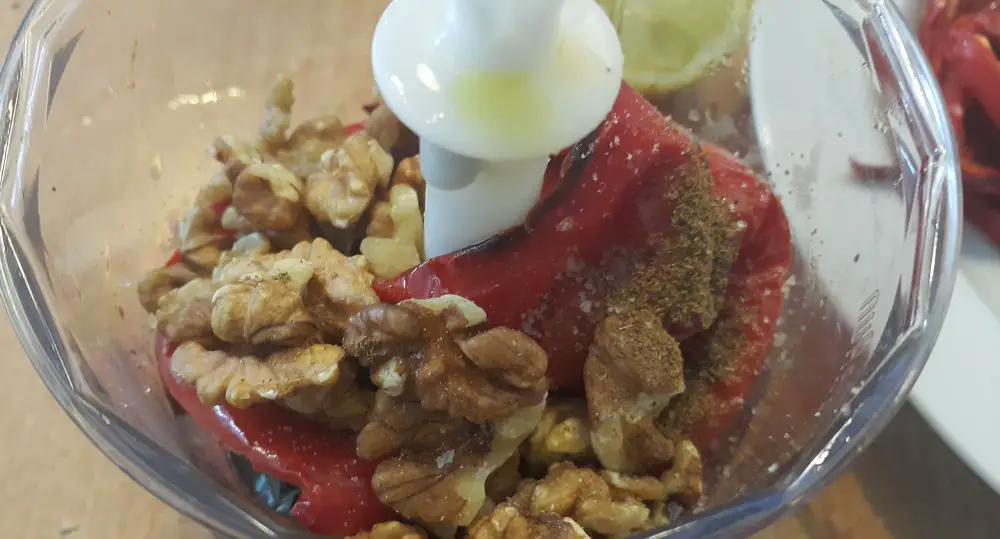
Once the peppers are done, you can replace them with other vegetables and make use of already hot oven. Alternatively, vegetables can be roasted in a pan or barbequed.
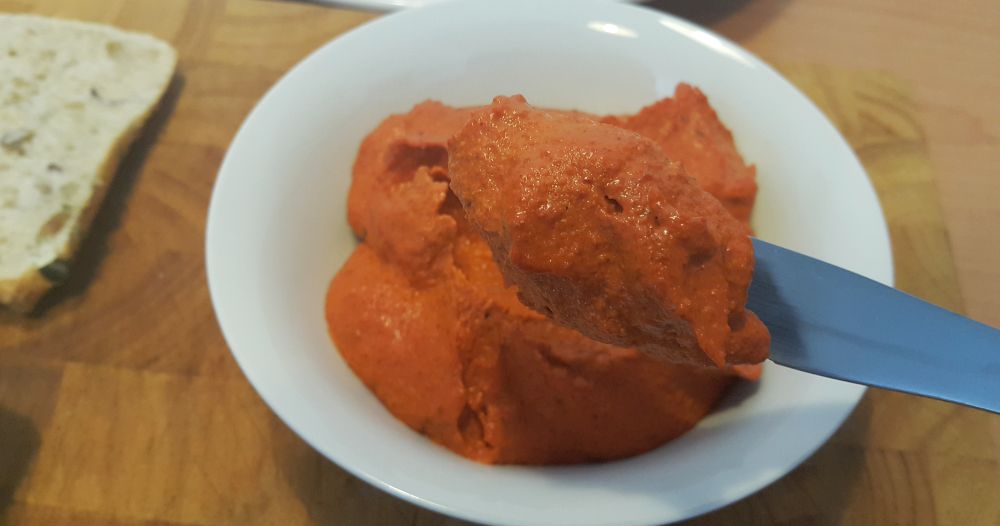
Now you can spread the red pepper dip on your bread or use it as a dip.
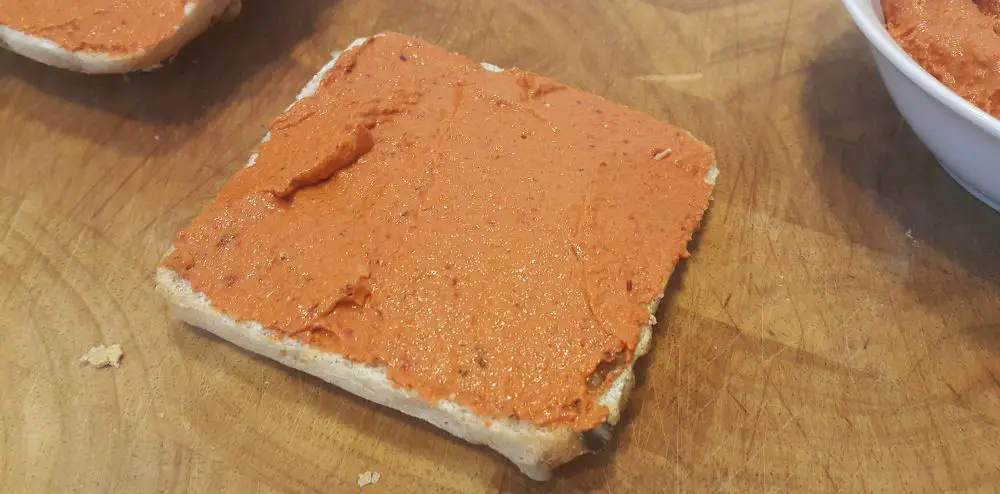
We made a sandwich first.
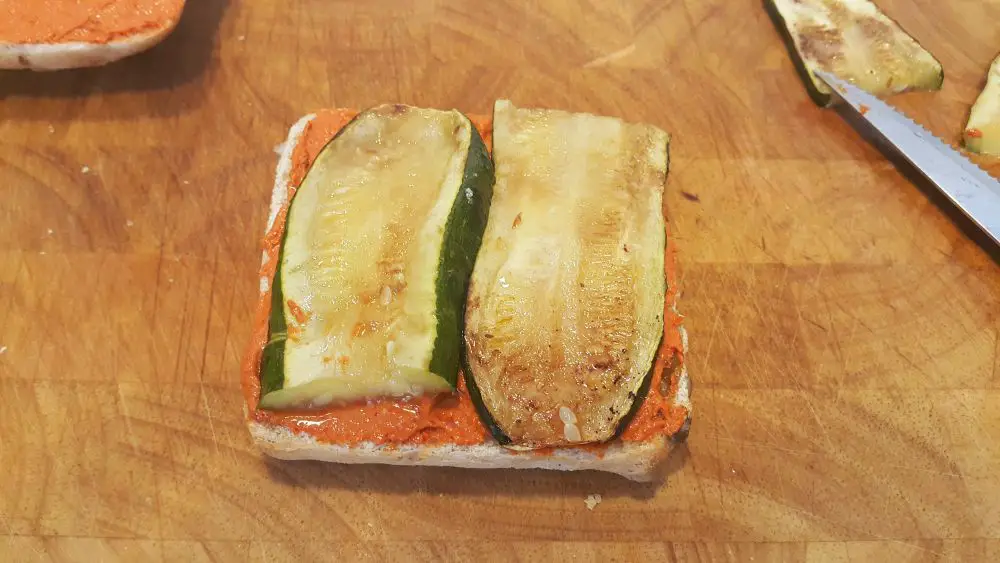
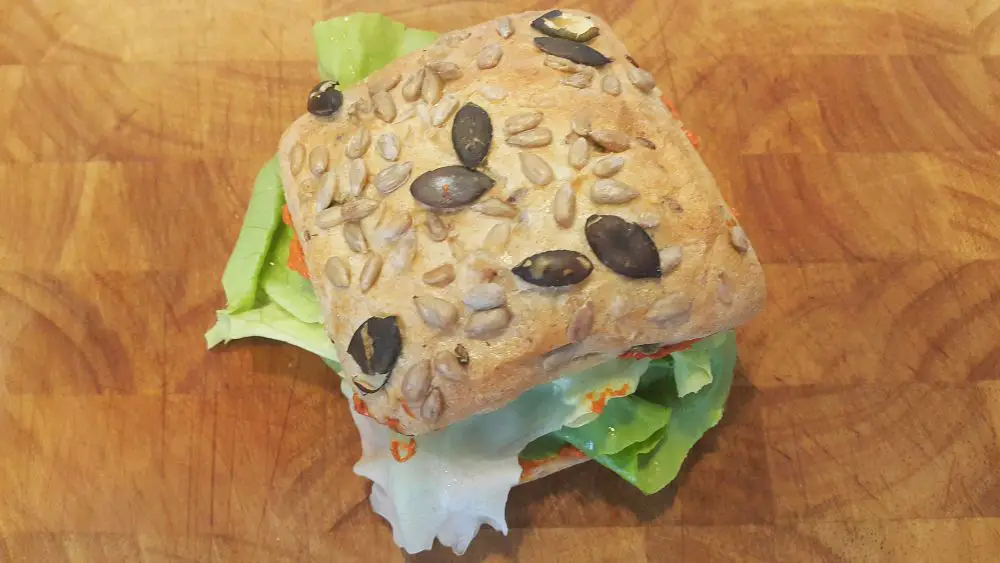
Then we added a bit of a dip on the top of it for every bite we made
Dober tek!
June 30, 2019
If you don’t find the image of a boiling octopus disturbing, you might want to try and prepare this creature in the way it is usually prepared and served along the eastern Adriatic coast: marinated in Trieste sauce and served on fresh lettuce leaves.
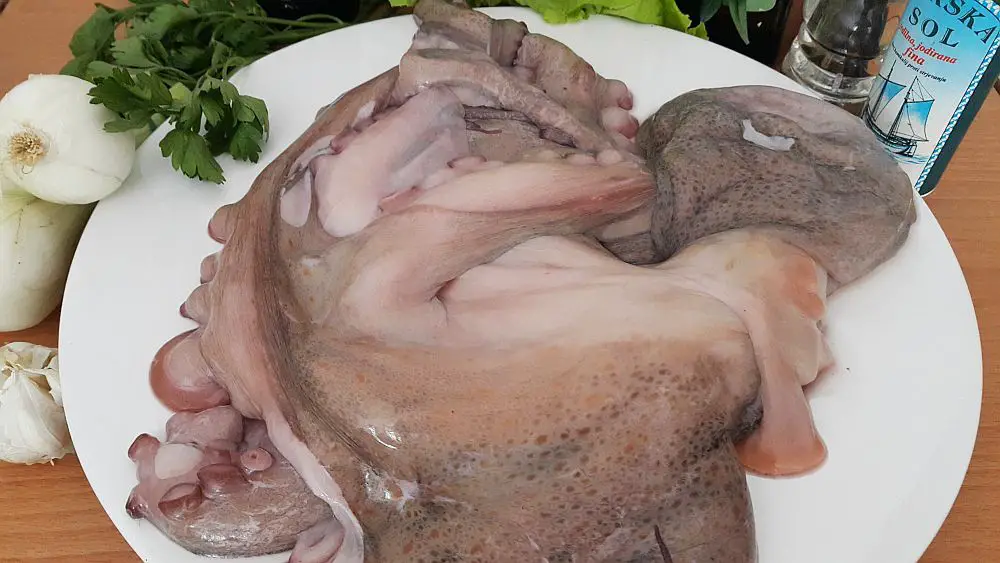
Ingredients:
1 onion for the pot, and you can also add bay leaves and whole pepper seeds
Clean the octopus and boil till soft (about an hour). If you have time, you can freeze the octopus before boiling (after you have cleaned it), which will make it more tender. Alternatively, you can beat it before cooking.
Smash the garlic cloves and chop the parsley for the marinade, which will also consist of olive oil, vinegar, lemon juice, salt and pepper. Take the cooked octopus out of the pot and remove the skin and suction cups in case you don't find them appetising. Dice the tentacles and marinade them for a few hours.
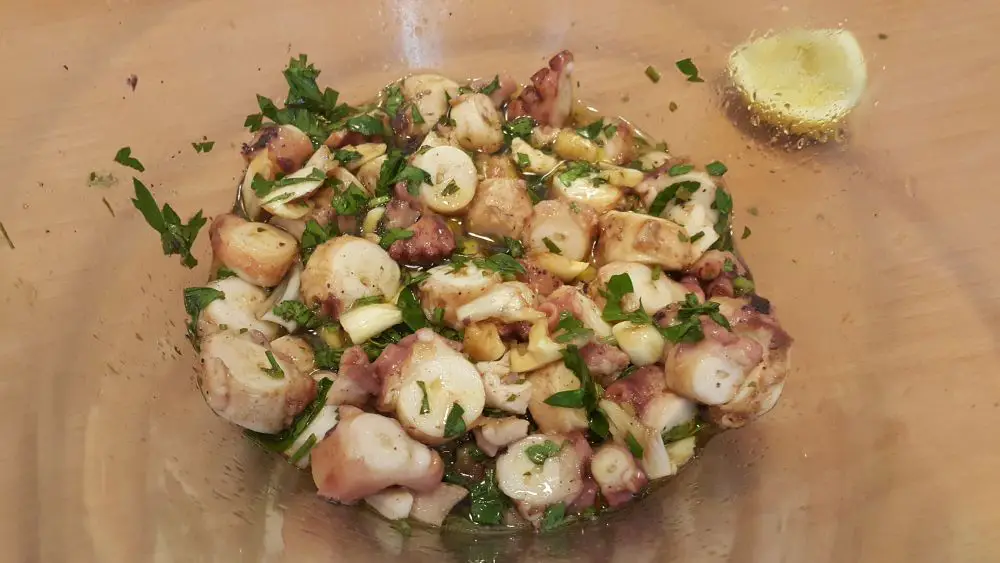
Take the salad out of the marinade and place it on fresh lettuce leaves for serving.
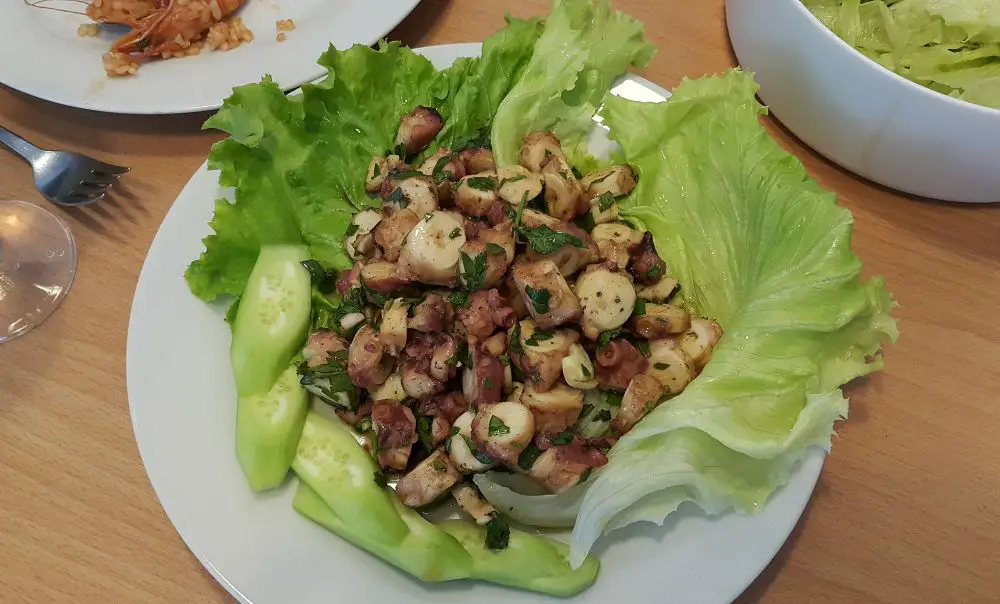
Dober tek!
June 12, 2019
Ljubljana Iceberg is an autochthonous Slovenian variety of crisp lettuce, which originates from Ljubljana and its inner and surrounding gardens, and in the 19th century spread to Graz, Vienna and Prague. It represents the main central Slovenian salad ingredient that has been dealt with as a delicacy - eaten fresh and only slightly seasoned with garlic, oil and vinegar. That is, at least till the 1970s, when fashions of taste changed in favour of more lasting lettuce varieties, which affected the development of this variety as well.
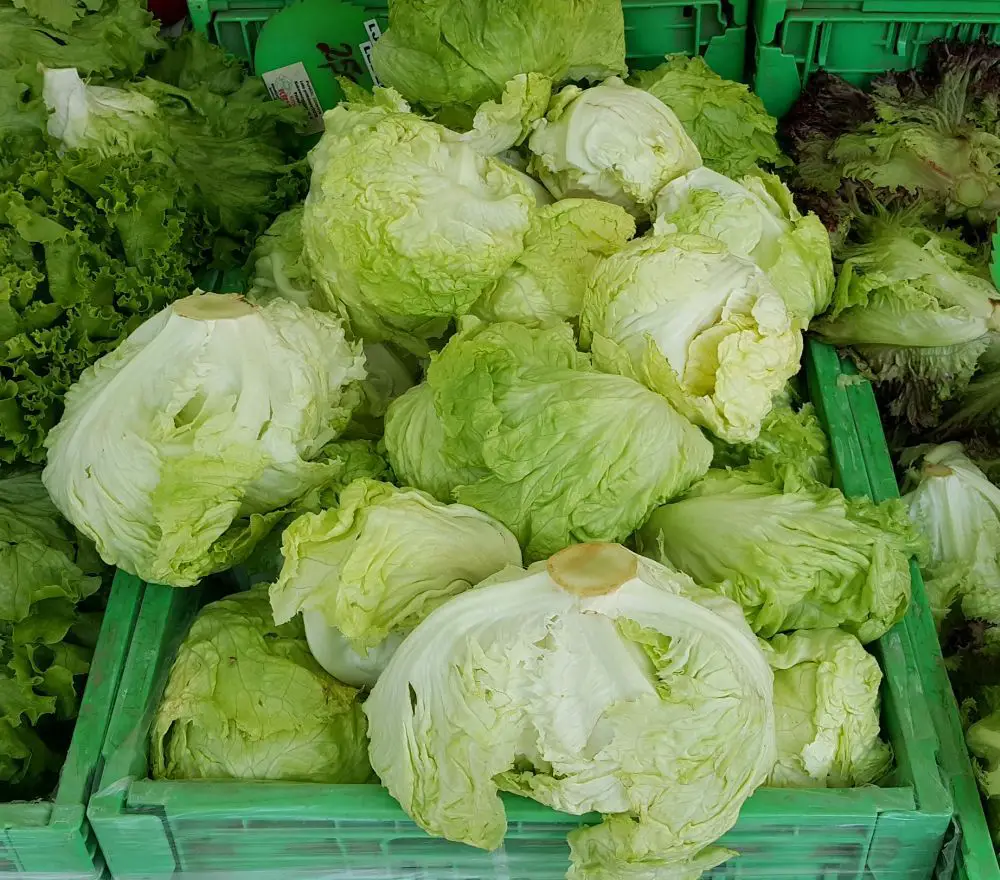
Originally, Ljubljana lettuce had a reddish edge on its leaves and did not have a pronounced head. It only lasted for a very short period of time after being taken from the garden and had to be eaten more or less the same day.
In the 1970s a red edge was no longer desirable for consumers in Slovenia; therefore, a breeding selection was made in favour of plants with a green edge and a bigger head.
In recent years autochthonous varieties and home grown produce has regained its previous value, and today the original Ljubljana Iceberg seeds with the red edge are available again, all thanks to the Agricultural Institute of Slovenia, who managed to find genetic samples of the original variety in Dutch, Czech and German gene banks (source) .
Since we have no garden, we had to buy our lettuce at the market place, where the only available version was the all green one. Which is fine as well.
Ljubljana Iceberg forms a fine a delicate salad and needs little extra excitement in the form of other ingredients. All we need is a pinch of salt, a chopped clove of fresh garlic, balsamic vinegar and olive oil.
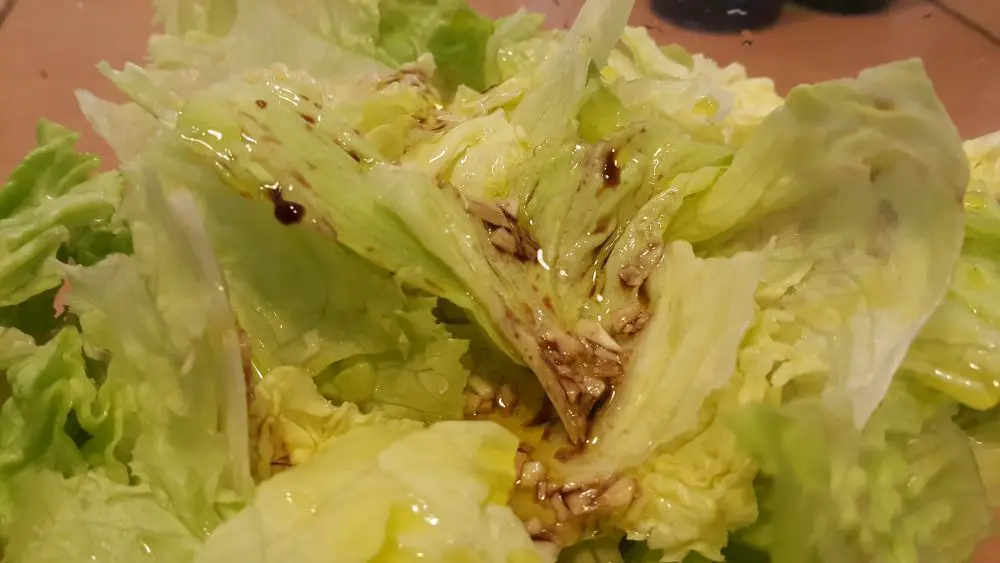
Serve immediately after seasoned.
Dober tek!
April 24, 2019
Frtalja, also fritaja is a common Littoral but also central Slovenian spring omelette made of chopped spring shoots of all kinds mixed into eggs and fried.
In the Littoral fritaja is often composed of one sort of greens, such as wild asparagus, lemon balm or fennel, while other ingredients usually join them in more central parts of the country, including nettle shoots, yarrow, chard, spring onion or wild garlic (ramsons).
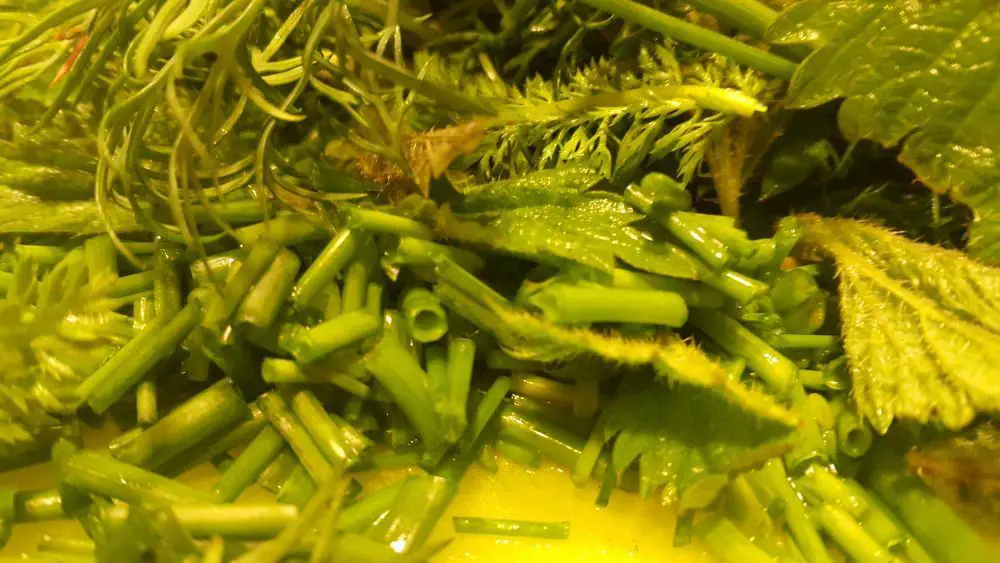
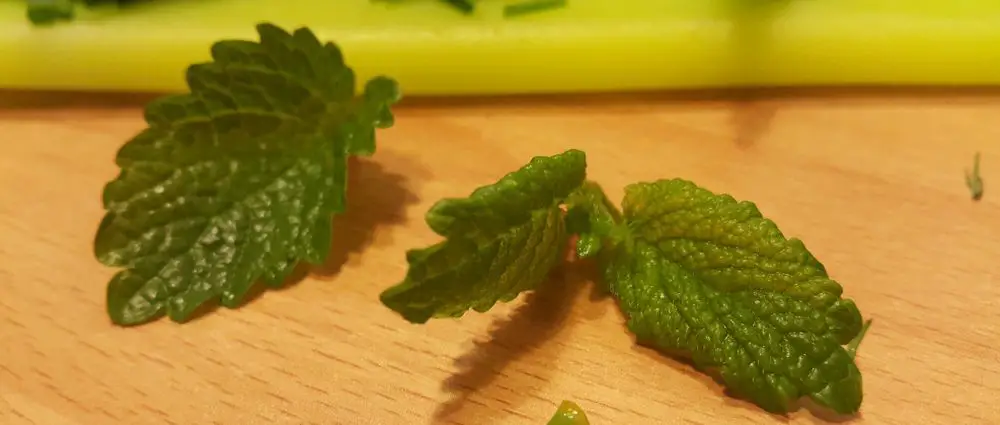
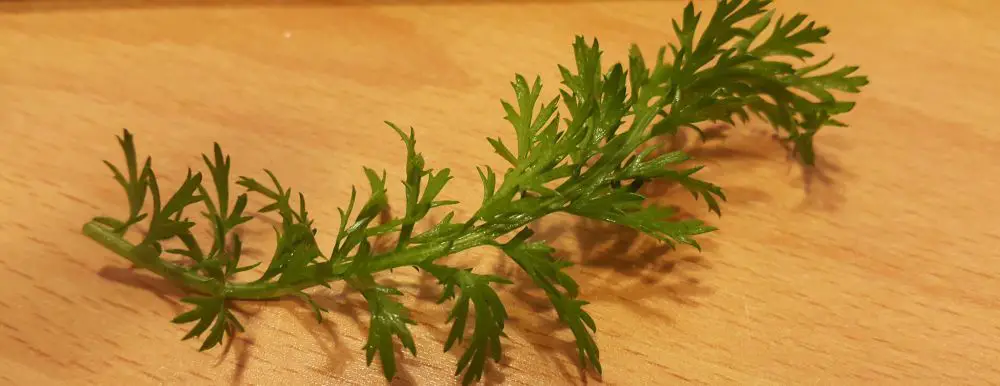
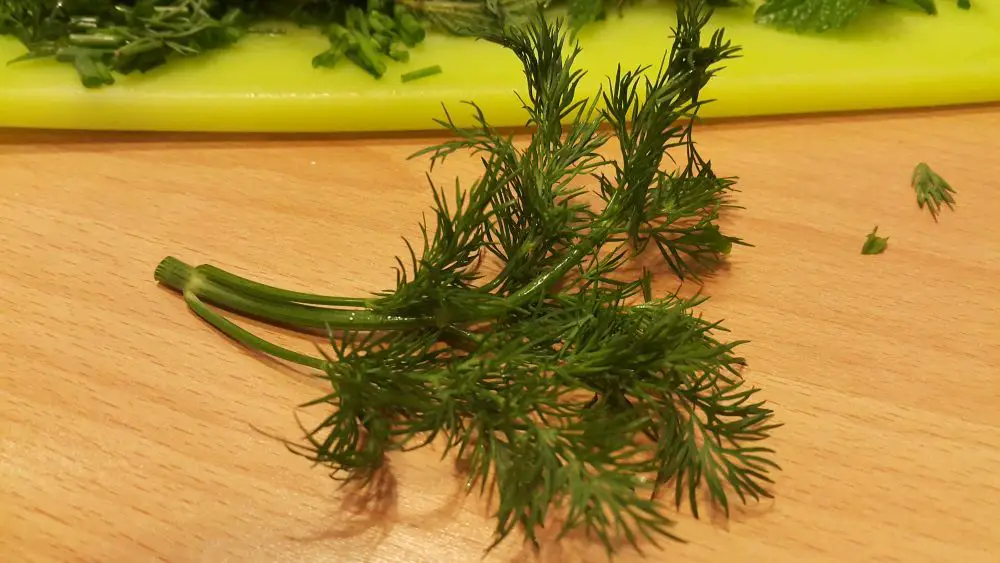
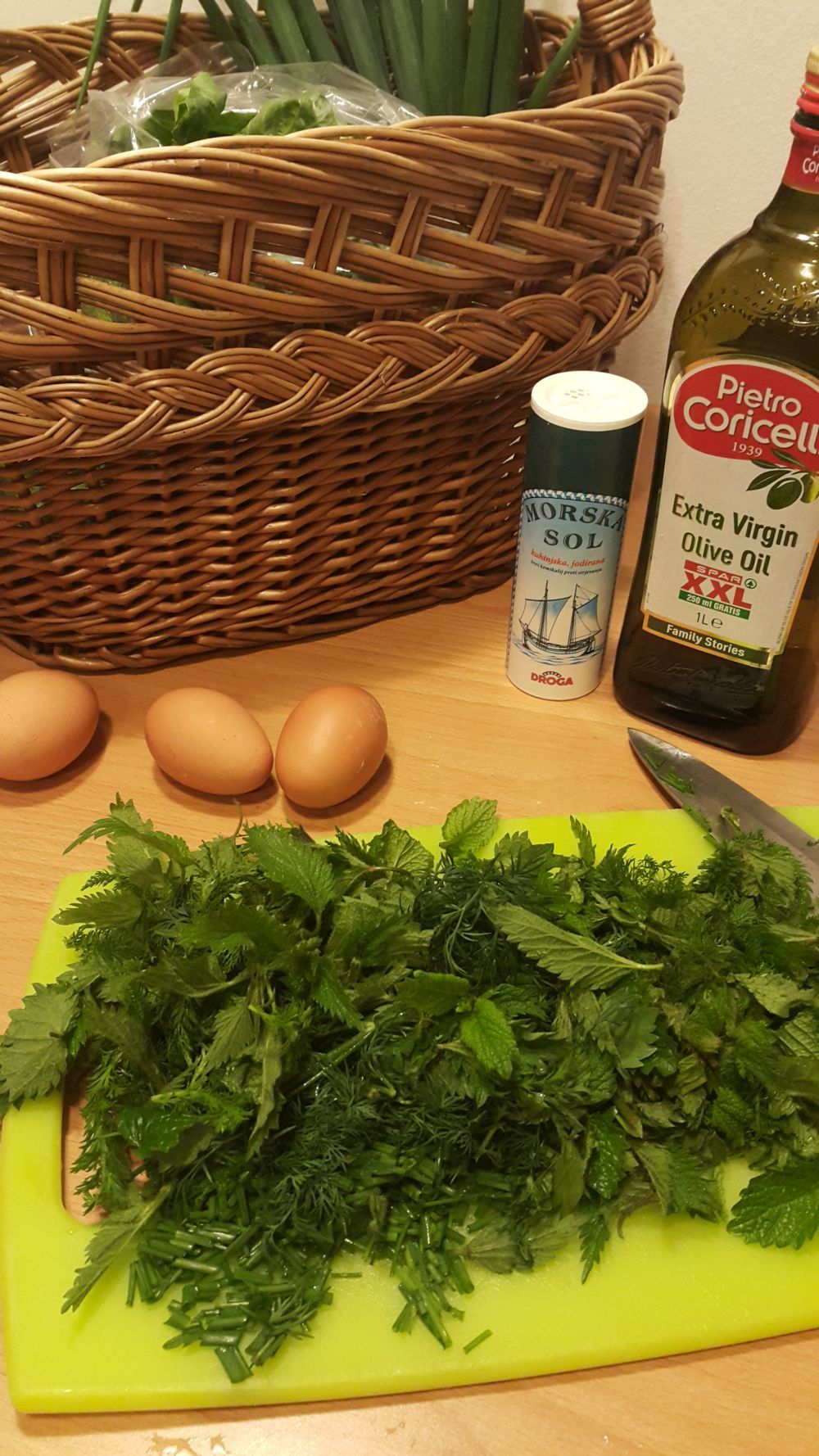
Ingredients:
Chop up herbs, whip the eggs, salt and mix all together.
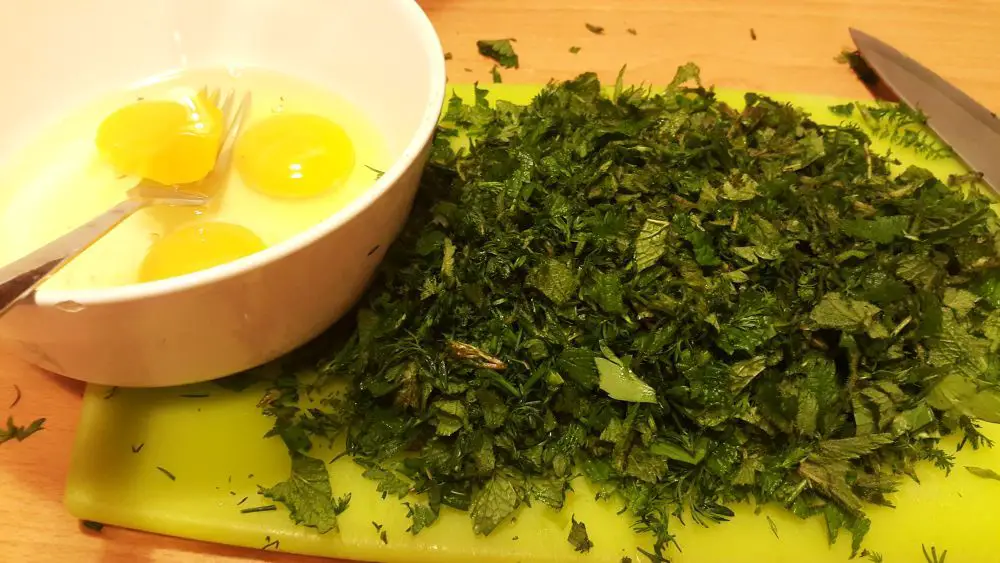
Preheat the pan, add some oil, spread the mixture across and cover.
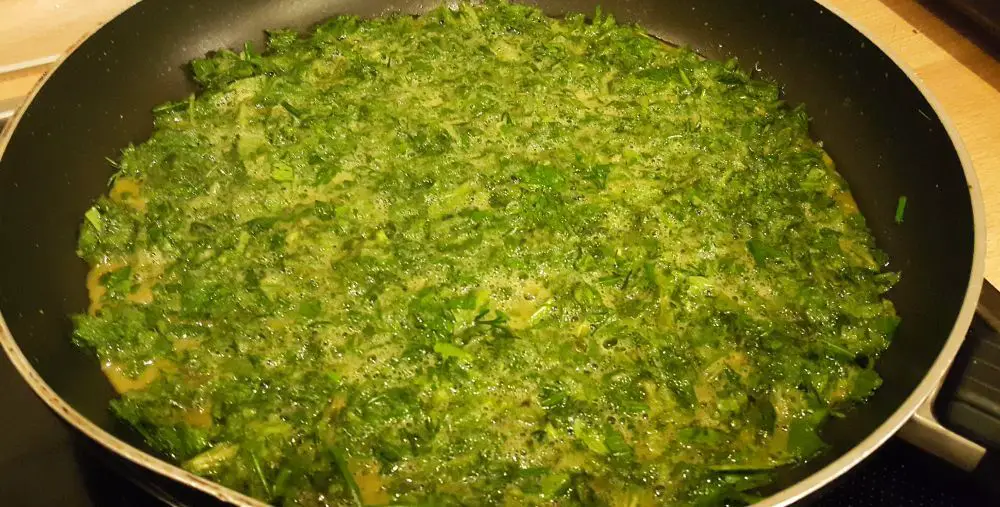
If your frtalja is rather thin and you worry it might break while being flipped over, divide it into four parts, then turn each one separately.
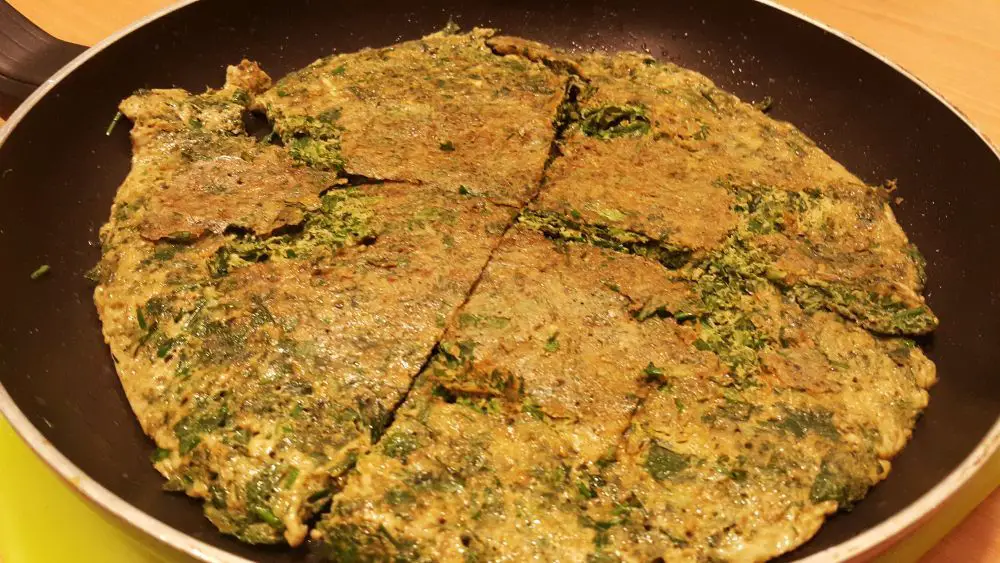
The whole thing should be done in about ten minutes or so.
Serve with any other spring dish or eat just like that.
Dober tek!
April 15, 2019
What fried rice is to the Far East bread dumplings are to Central Europe: a culinary answer to the problem of staple food leftovers. The solution in both cases comes in a dish that is often a favourite of both kids and adults. Bread dumplings are usually served with meat and gravy, mushroom sauces or goulash, in our case Segedin.
As usual, there are certain things one wants to pay attention to in order to avoid some unwanted results. With bread dumplings, this means we don’t want the mixture to be too sticky when shaping it into balls, or too hard once boiled and ready to eat. And we just might have found the perfect recipe.
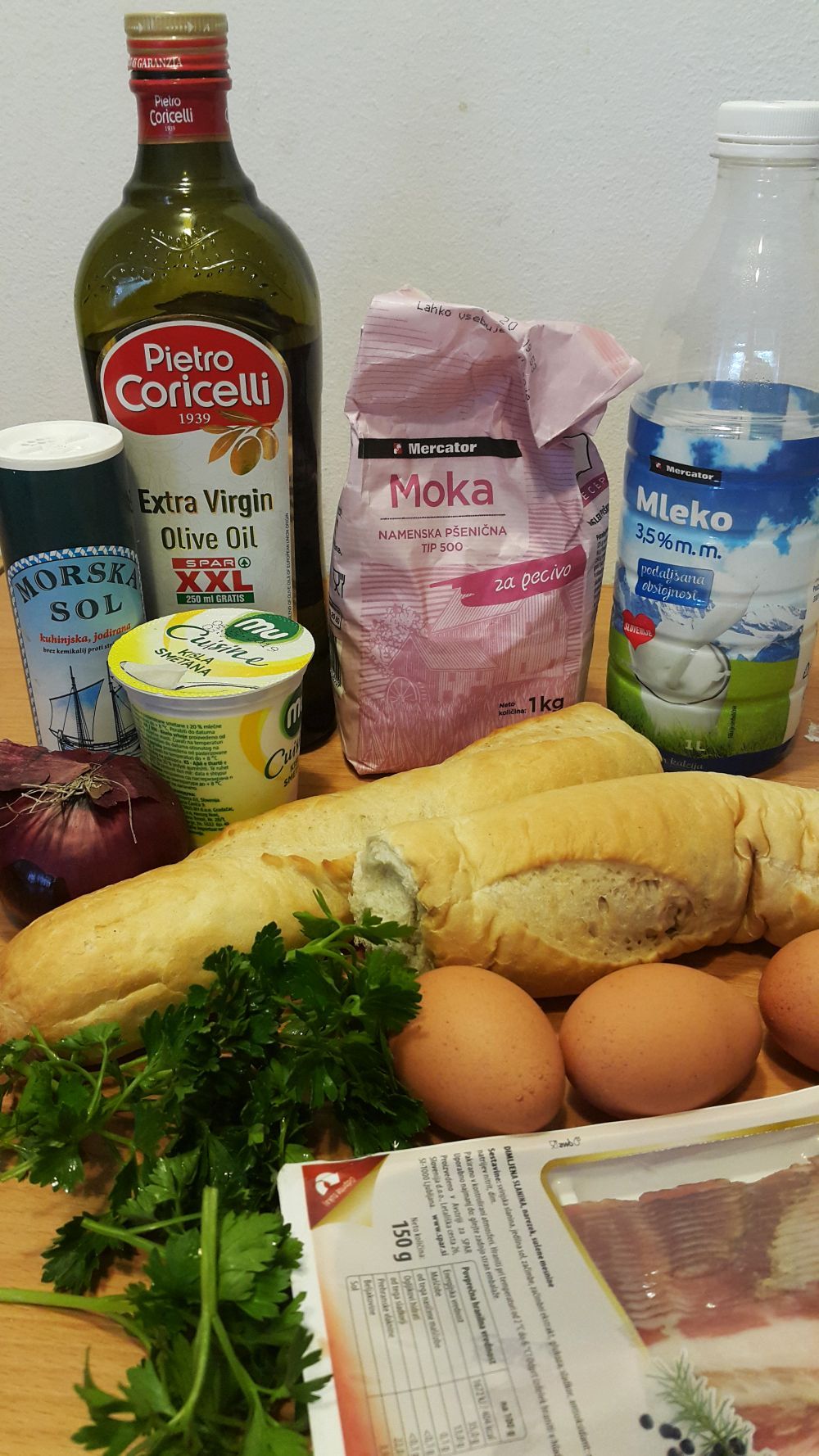
Chop the onion and bacon and stir fry in olive oil till the onion softens. Dice the bread and add it to the pan. Let it fry a little and soak the fat in.
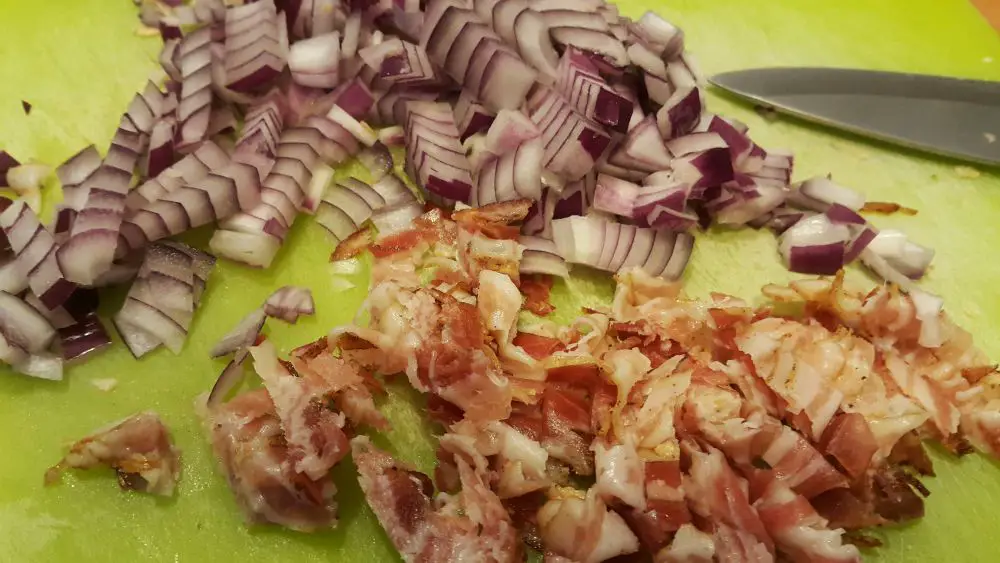
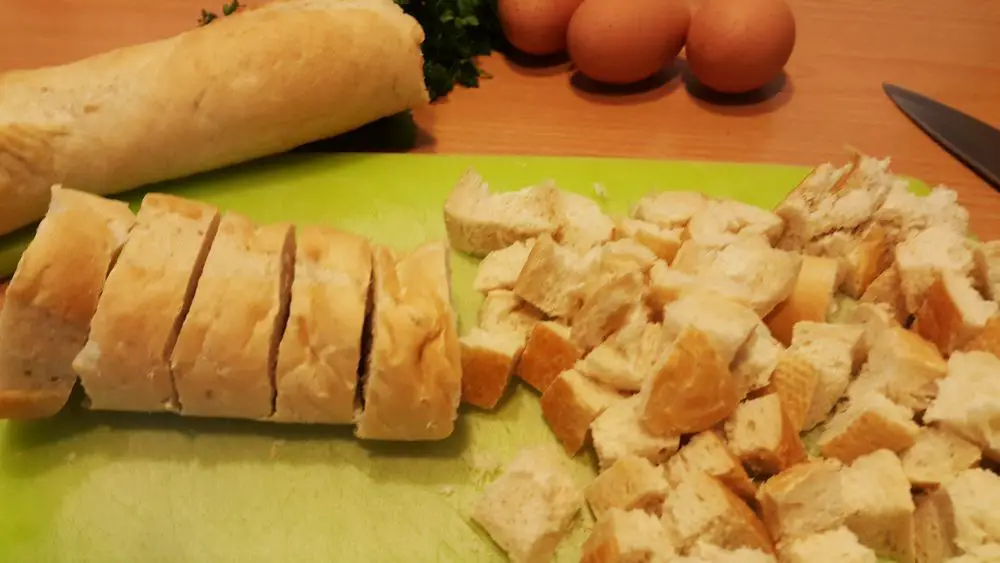
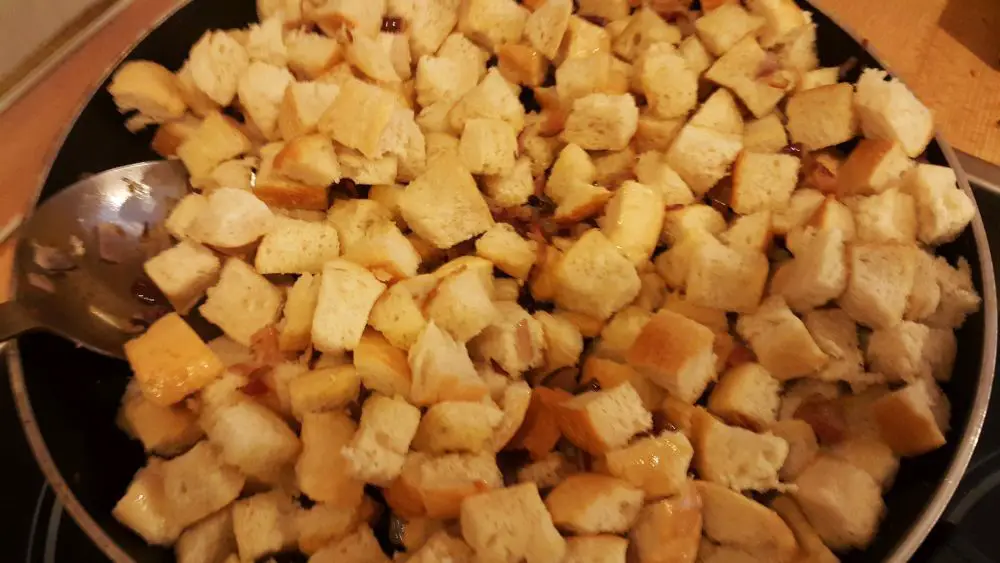
Move the bread mixture into a bowl and wait till it cools down. Mix the eggs with the sour cream and milk and stir into the bread mixture. Add flour and parsley and mix again. Leave it to rest for 10 to 15 minutes, then shape into balls using your hands.
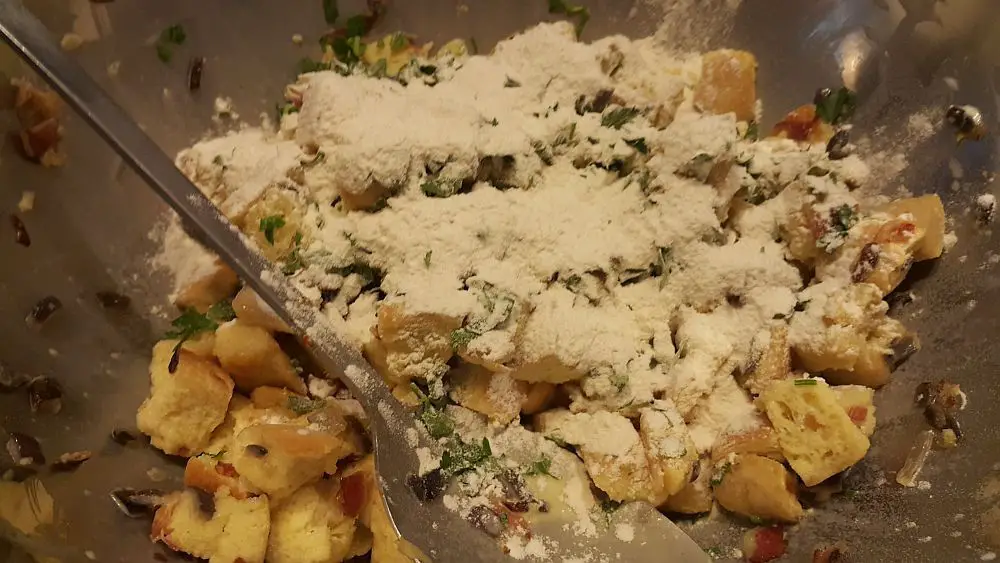


Boil the dumplings in salted water for about 10 minutes, then take them out and serve them with a mushroom sauce, meat and (lots of) gravy, goulash or Segedin.

Dober tek!
April 15, 2019
This dish made of sauerkraut and meat originates from the Hungarian side of the Austro-Hungarian Empire, and is especially common among the Slavic people who were once part of the Empire.
There is some discord, however, about the actual origin of the dish, and hence about the right name that goes with it. In Slovenia, and as internet searches would suggest, Slovakia and the Czech Republic as well, it is believed that the dish originates from a Hungarian town called Szeged, which is why it is called Segedin or Szeged Goulash. In Hungary and the rest of the Yugoslav Balkans, it is believed that the dish was accidentally invented by a 19th century Hungarian poet and journalist, Jozsef Székély, which is why it should also be called székelygulyása or Szekely goulash. The story goes that Székély once walked into a guest house in the late hours of the evening and was told they had nothing left but some sauerkraut and cooked meat. “Put both together and heat them up” was his order, and thus Szekely goulash, (Segedin in Slovenian and Slovakian) was born.
Most people in Slovenia are not familiar with the story and don’t place much importance on the origin of the dish either, but rather take it as their own, as one of the varieties of ways of to ingest sauerkraut in the wintertime. As far as we are concerned, it is one of the best ones, easy to make and especially good when served with bread dumplings.
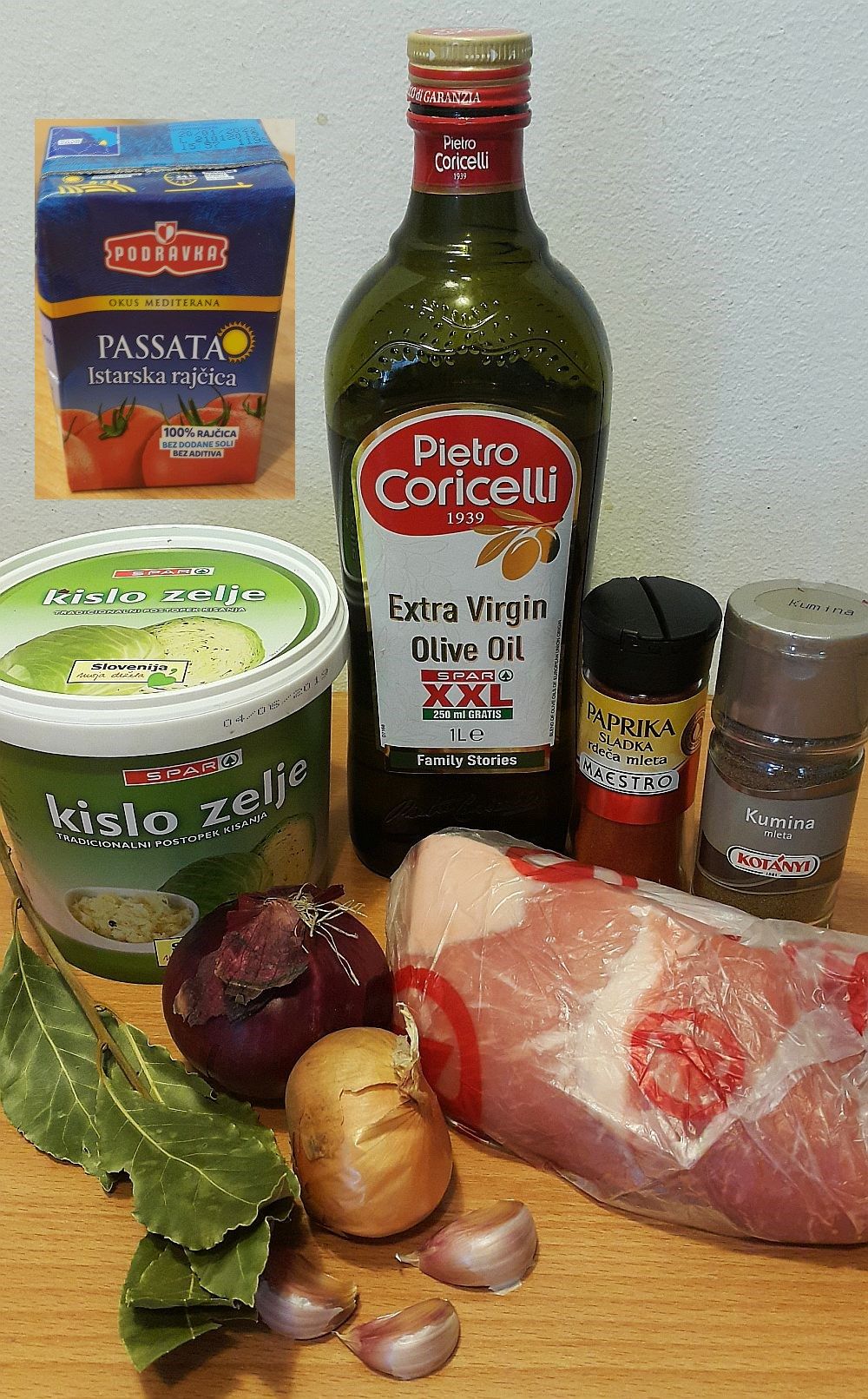
Dice the onion and some garlic, stir fry in the olive oil until the onion softens up and becomes glassy.
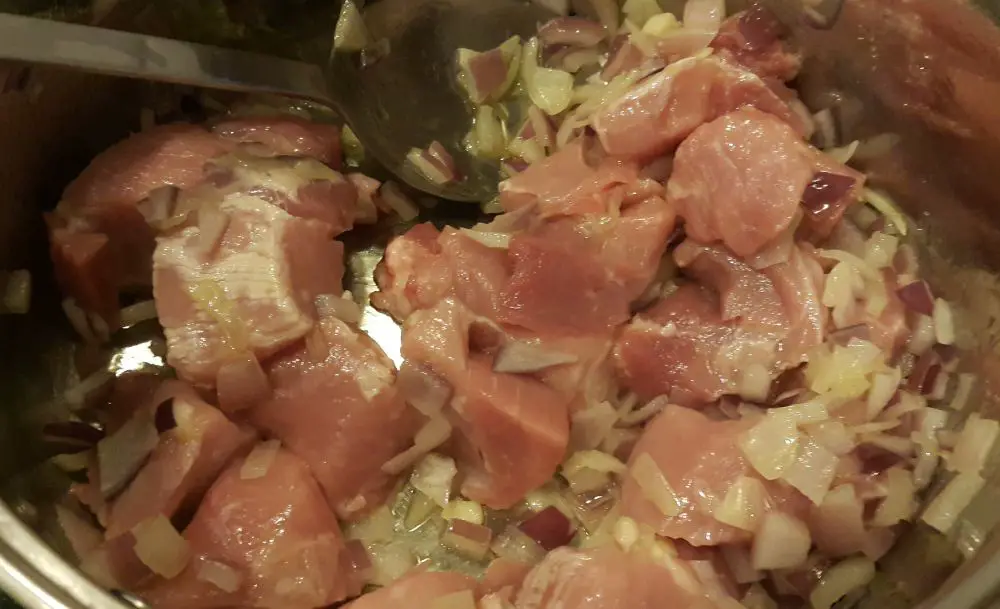
Add diced meat and stew in its own juice for 15-20 minutes until it softens. Then add paprika, caraway and passata and stir it all with the meat. Add sauerkraut, bay leaves and enough water so that everything is more or less submerged.

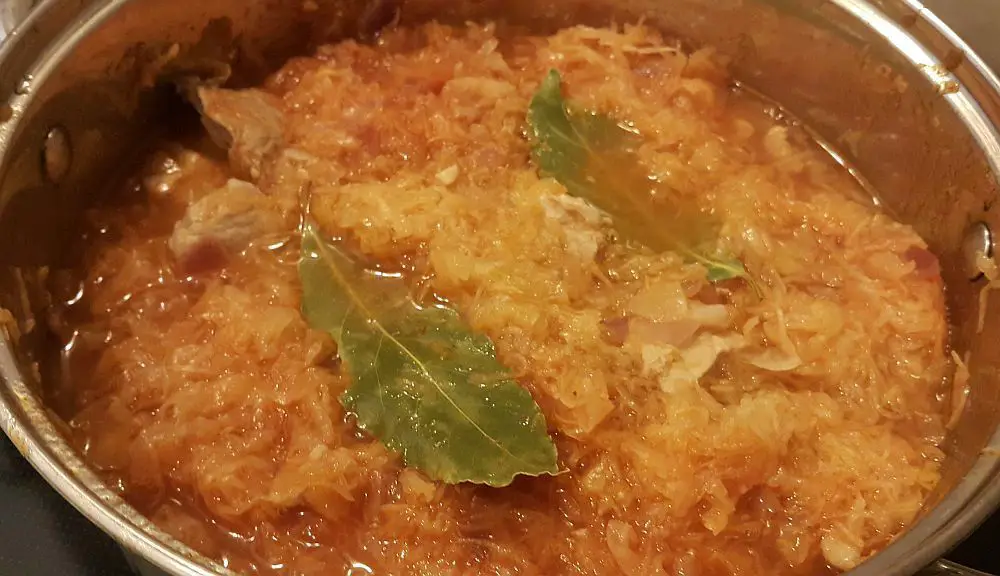
Let it simmer for another hour or so, then serve with bread dumplings.

Dober tek!


